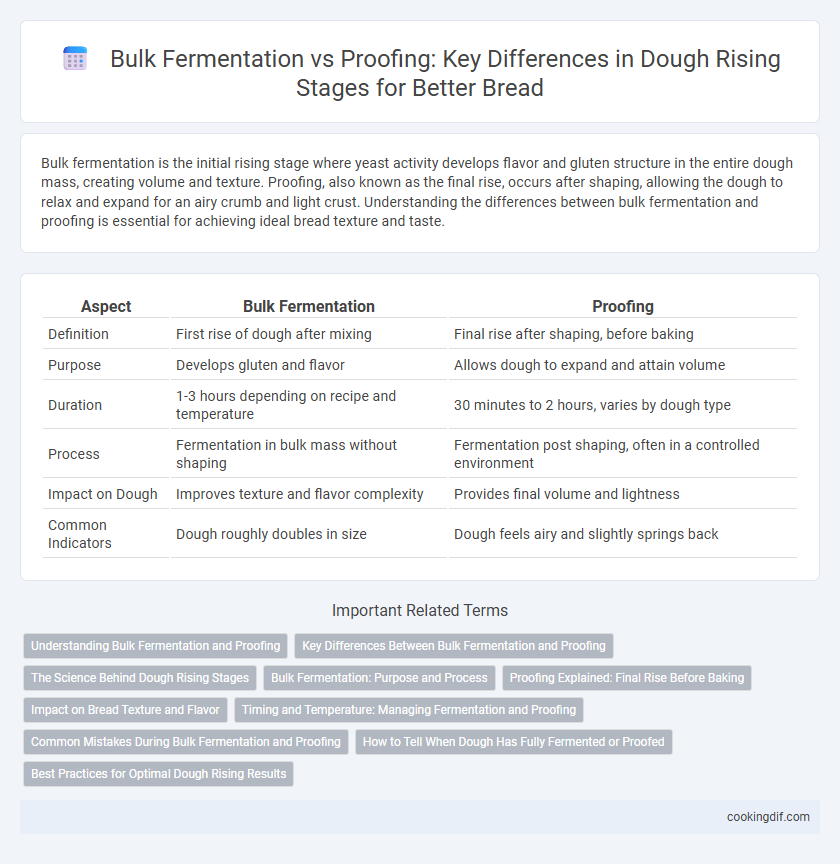Bulk fermentation is the initial rising stage where yeast activity develops flavor and gluten structure in the entire dough mass, creating volume and texture. Proofing, also known as the final rise, occurs after shaping, allowing the dough to relax and expand for an airy crumb and light crust. Understanding the differences between bulk fermentation and proofing is essential for achieving ideal bread texture and taste.
Table of Comparison
| Aspect | Bulk Fermentation | Proofing |
|---|---|---|
| Definition | First rise of dough after mixing | Final rise after shaping, before baking |
| Purpose | Develops gluten and flavor | Allows dough to expand and attain volume |
| Duration | 1-3 hours depending on recipe and temperature | 30 minutes to 2 hours, varies by dough type |
| Process | Fermentation in bulk mass without shaping | Fermentation post shaping, often in a controlled environment |
| Impact on Dough | Improves texture and flavor complexity | Provides final volume and lightness |
| Common Indicators | Dough roughly doubles in size | Dough feels airy and slightly springs back |
Understanding Bulk Fermentation and Proofing
Bulk fermentation is the initial rising stage where yeast ferments the entire dough mass, producing carbon dioxide and developing gluten structure, essential for flavor and texture. Proofing, or final fermentation, occurs after shaping and allows the dough to rise further, refining crumb softness and volume. Both stages are critical in controlling dough consistency, flavor complexity, and overall bread quality.
Key Differences Between Bulk Fermentation and Proofing
Bulk fermentation is the initial stage where yeast activity causes the dough to rise as gluten develops, typically lasting several hours depending on temperature and yeast concentration. Proofing, or final fermentation, occurs after shaping the dough, allowing it to rise again before baking, which refines texture and volume. The key differences lie in timing, purpose, and dough handling: bulk fermentation focuses on dough development and gas production, while proofing prepares dough for optimal oven spring and final crumb structure.
The Science Behind Dough Rising Stages
Bulk fermentation allows yeast to produce carbon dioxide and alcohol, developing gluten structure and flavor complexity throughout the dough. Proofing is the final rise after shaping, where the yeast activates again to create a lighter, airier crumb by expanding gas bubbles within the dough. Understanding the biochemical activity of yeast and gluten network development during these stages is essential for achieving optimal texture and taste in bread.
Bulk Fermentation: Purpose and Process
Bulk fermentation is the initial dough rising stage where yeast activity produces carbon dioxide, causing the dough to expand and develop flavor. This process enhances gluten structure, improves dough texture, and allows enzymes to break down starches into sugars, feeding the yeast. Proper temperature and time control during bulk fermentation are critical for optimal dough rise and fermentation byproducts that contribute to bread aroma and taste.
Proofing Explained: Final Rise Before Baking
Proofing is the critical final rise where shaped dough rests before baking, allowing yeast to ferment and produce gases that create volume and texture. This stage influences the bread's crumb structure, flavor development, and oven spring, requiring precise temperature and humidity control for optimal results. Unlike bulk fermentation, which is the initial rise of unshaped dough, proofing finalizes the dough's expansion and readiness for baking.
Impact on Bread Texture and Flavor
Bulk fermentation enhances bread texture by allowing gluten development and gas retention, resulting in a chewier crumb and complex flavor due to extended yeast activity and flavor compound formation. Proofing, the final rise after shaping, fine-tunes dough structure and contributes to a lighter, more open crumb with subtle flavor refinement. Proper control of both stages is essential for balanced texture and depth of taste in artisanal bread.
Timing and Temperature: Managing Fermentation and Proofing
Bulk fermentation typically occurs at 75degF to 78degF and lasts 1 to 3 hours, allowing yeast to develop flavor and structure as dough rises once. Proofing, performed after shaping at slightly cooler temperatures around 70degF to 75degF, usually takes 30 minutes to 2 hours, focusing on final dough expansion before baking. Proper timing and temperature control in both stages optimize yeast activity, gluten development, and dough texture for superior bread quality.
Common Mistakes During Bulk Fermentation and Proofing
Common mistakes during bulk fermentation include underproofing, which prevents proper gluten development and flavor formation, and overproofing, causing dough to collapse or lose structure. During proofing, excessive handling can deflate dough, while insufficient humidity leads to a dry crust that hinders oven spring. Controlling temperature and timing precisely is crucial to avoid these issues and achieve optimal dough rise.
How to Tell When Dough Has Fully Fermented or Proofed
Dough that has fully bulk fermented typically doubles in size, showing a smooth surface with visible gas bubbles underneath, indicating active yeast metabolism. During proofing, the dough becomes soft and slightly jiggly, and passes the "poke test" when an indentation springs back slowly without disappearing. Monitoring fermentation temperature and timing closely ensures optimal dough rise and flavor development at each stage.
Best Practices for Optimal Dough Rising Results
Bulk fermentation promotes yeast activity and gluten development by allowing the entire dough mass to rise before shaping, typically lasting 1 to 3 hours at 75degF to 80degF. Proofing occurs after shaping and focuses on final dough relaxation and volume increase, usually for 30 minutes to 2 hours with controlled humidity around 75%. Maintaining precise temperature, humidity, and timing during both stages ensures optimal gas retention and dough structure, resulting in superior bread texture and crumb.
Bulk Fermentation vs Proofing for dough rising stages Infographic

 cookingdif.com
cookingdif.com